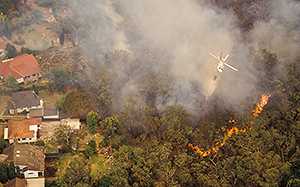Wildfires
 Climate change is increasing the vulnerability of many forests to wildfires. Climate change is also projected to increase the frequency of wildfires in certain regions of the United States. Long periods of record high temperatures are associated with droughts that contribute to dry conditions and drive wildfires in some areas. Wildfire smoke contains particulate matter, carbon monoxide, nitrogen oxides, and various volatile organic compounds (which are ozone precursors) and can significantly reduce air quality, both locally and in areas downwind of fires.
Climate change is increasing the vulnerability of many forests to wildfires. Climate change is also projected to increase the frequency of wildfires in certain regions of the United States. Long periods of record high temperatures are associated with droughts that contribute to dry conditions and drive wildfires in some areas. Wildfire smoke contains particulate matter, carbon monoxide, nitrogen oxides, and various volatile organic compounds (which are ozone precursors) and can significantly reduce air quality, both locally and in areas downwind of fires.
Smoke exposure increases respiratory and cardiovascular hospitalizations; emergency department visits; medication dispensations for asthma, bronchitis, chest pain, chronic obstructive pulmonary disease (commonly known by its acronym, COPD), and respiratory infections; and medical visits for lung illnesses. It has been associated with hundreds of thousands of deaths annually, based on an assessment of the global health risks from landscape fire smoke. Future climate change is projected to increase wildfire risks and associated emissions, with harmful impacts on health.
- Page last reviewed: December 11, 2014
- Page last updated: December 11, 2014
- Content source:


 ShareCompartir
ShareCompartir